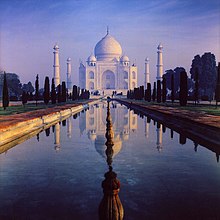
Considered to be an "unrivaled architectural wonder", the Taj MahalAgra is a prime example of Indo-Islamic architecture. in
Indian architecture encompasses a multitude of expressions over space and time, constantly absorbing new ideas. The result is an evolving range of architectural production that nonetheless retains a certain amount of continuity across history. Some of its earliest production are found in the Indus Valley Civilization (2600–1900 BC) which is characterised by well planned cities and houses. Religion and kingship do not seem to have played an important role in the planning and layout of these towns.
During the period of the Mauryan and Gupta empires and their successors, several Buddhist architectural complexes, such as the caves of Ajanta and Ellora and the monumental Sanchi Stupa were built. Later on, South India produced several Hindu temples like Chennakesava Temple at Belur, the Hoysaleswara TempleHalebidu, and the Kesava Temple at Somanathapura, Brihadeeswara Temple, Thanjavur, the Sun Temple, Konark, Sri Ranganathaswamy Temple at Srirangam, and the Buddha stupa (Chinna Lanja dibba and Vikramarka kota dibba) at Bhattiprolu. Angkor Wat, Borobudur and other Buddhist and Hindu temples indicate strong Indian influence on South East Asian architecture, as they are built in styles almost identical to traditional Indian religious buildings. at
The traditional system of Vaastu Shastra serves as India's version of Feng Shui, influencing town planning, architecture, and ergonomics. It is unclear which system is older, but they contain certain similarities. Feng Shui is more commonly used throughout the world. Though Vastu is conceptually similar to Feng Shui in that it also tries to harmonize the flow of energy, (also called life-force or Prana in Sanskrit and Chi/Ki in Chinese/Japanese), through the house, it differs in the details, such as the exact directions in which various objects, rooms, materials, etc. are to be placed.
With the advent of Islamic influence from the west, Indian architecture was adapted to allow the traditions of the new religion. Fatehpur Sikri, Taj Mahal, Gol Gumbaz, Qutub Minar, Red Fort of Delhi are creations of this era, and are often used as the stereotypical symbols of India. The colonial rule of the British Empire saw the development of Indo-Saracenic style, and mixing of several other styles, such as European Gothic. The Victoria Memorial or the Chhatrapati Shivaji Terminus are notable examples.
Indian architecture has influenced eastern and southeastern Asia, due to the spread of Buddhism. A number of Indian architectural features such as the temple mound or stupa, temple spire or sikhara, temple tower or pagoda and temple gate or torana, have become famous symbols of Asian culture, used extensively in East Asia and South East Asia. The central spire is also sometimes called a vimanam. The southern temple gate, or gopuram is noted for its intricacy and majesty.
Contemporary Indian architecture is more cosmopolitan. Cities are extremely compact and densely populated. Mumbai's Nariman Point is famous for its Art Deco buildings. Recent creations such as the Lotus Temple, and the various modern urban developments of India like Chandigarh, are notable.


No comments:
Post a Comment